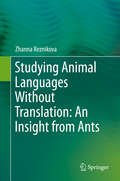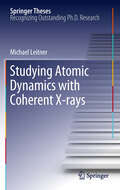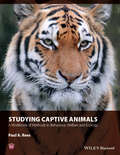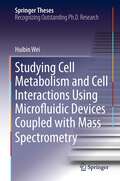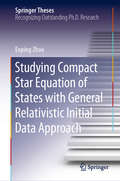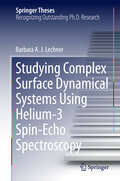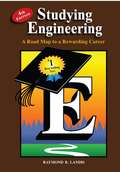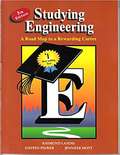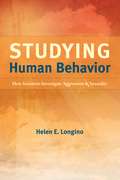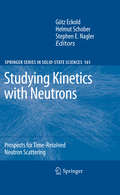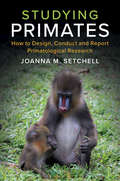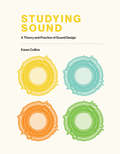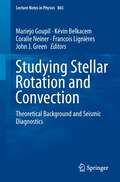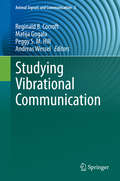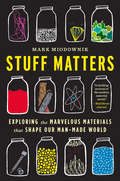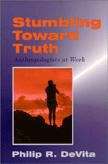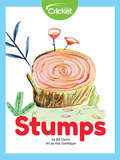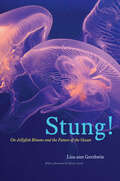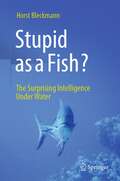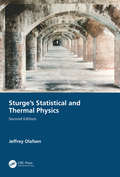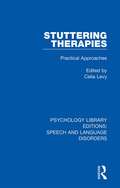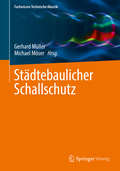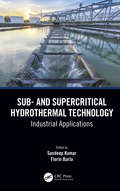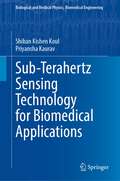- Table View
- List View
Studying Animal Languages Without Translation: An Insight from Ants
by Zhanna ReznikovaThe Author of this new volume on ant communication demonstrates that information theory is a valuable tool for studying the natural communication of animals. To do so, she pursues a fundamentally new approach to studying animal communication and “linguistic” capacities on the basis of measuring the rate of information transmission and the complexity of transmitted messages.Animals’ communication systems and cognitive abilities have long-since been a topic of particular interest to biologists, psychologists, linguists, and many others, including researchers in the fields of robotics and artificial intelligence. The main difficulties in the analysis of animal language have to date been predominantly methodological in nature. Addressing this perennial problem, the elaborated experimental paradigm presented here has been applied to ants, and can be extended to other social species of animals that have the need to memorize and relay complex “messages”. Accordingly, the method opens exciting new dimensions in the study of natural communications in the wild.
Studying Atomic Dynamics with Coherent X-rays
by Michael LeitnerDiffusion in solids at moderate temperatures is a well-known phenomenon. However, direct experimental evidence about the responsible atomic-scale mechanisms has been scarce, due to difficulties in probing the relevant length- and time-scales. The present thesis deals with the application of X-ray Photon Correlation Spectroscopy (XPCS) for answering such questions. This is an established method for the study of slow dynamics on length-scales of a few nanometres. The scattered intensity in the diffuse regime, i.e. corresponding to atomic distances, is very low, however, and so it has so far been considered impossible to use XPCS for this problem. Threefold progress is reported in this work: It proposes a number of systems selected for high diffuse intensity, it optimizes the photon detection and data evaluation procedures, and it establishes theoretical models for interpretating the results. Together these advances allowed the first successful atomic-scale XPCS experiment, which elucidated the role of preferred configurations for atomic jumps in a copper-gold alloy. The growth in available coherent X-ray intensity together with next-generation X-ray sources will open up a wide field of application for this new method.
Studying Captive Animals
by Paul A. ReesStudying Captive Animals outlines the methods that may be used to study the behaviour, welfare and ecology of animals living under the control of humans, including companion animals, feral populations, and those living on farms and in zoos. This book is a step-by-step guide to the whole process of conducting a scientific study: from designing the original project, formulating testable hypotheses, and collecting and analysing the data, to drawing conclusions from the work and writing it up as a scientific report or paper. It also illustrates how to write a formal research proposal - a crucial and often difficult element of the student project - and how to deal with the ethical review process. Sample data collection sheets are provided and the analysis and presentation of data are worked through in diagrammatic form. In addition, exercises are included that enable the reader to practice analysing different types of data and advice is provided on the selection of appropriate statistical tests. The text describes the different types of student projects that may be undertaken in the field, and explains where secondary data may be found for zoos. This is an insightful resource, particularly for those studying and working with zoo and farm animals. It is essential reading for students studying zoo biology and animal management; it is also suitable for students on courses in animal behaviour, animal welfare, zoology, biology, psychology, animal science, animal production, animal ecology, conservation biology, and veterinary science. This book is primarily intended for undergraduates but will also be of value to postgraduate students who have not previously engaged in field studies. Professionals working in institutions that are members of the World Association of Zoos and Aquariums, the European Association of Zoos and Aquaria and other regional and national zoo organisations will benefit from access to this practical guide.
Studying Cell Metabolism and Cell Interactions Using Microfluidic Devices Coupled with Mass Spectrometry
by Huibin WeiThis thesis describes a new approach for cell analysis by the rapid developing microfluidic technology. The nominee has made great contributions to develop a new analysis platform which combined microfluidic devices with mass spectrometry to determine the trace compounds secreted by cells. Based on this analysis platform, she studied the specific cell secreting behaviors under controlled microenvironment, of which the secretion compounds were qualified and semi-quantified by mass spectrometry. A novel cell sorting device integrated homogenous porous PDMS membrane was invented to classify cells from real samples based on the size difference. The nominee further studied the signal transmission between different cells, and the signal chemicals were qualitative and quantitative monitored by the analysis platform. This indicates the potential significant application of the new cell analysis platform in medicine screening and early diagnosis.
Studying Compact Star Equation of States with General Relativistic Initial Data Approach (Springer Theses)
by Enping ZhouThis book focuses on the equation of state (EoS) of compact stars, particularly the intriguing possibility of the “quark star model.” The EoS of compact stars is the subject of ongoing debates among astrophysicists and particle physicists, due to the non-perturbative property of strong interaction at low energy scales. The book investigates the tidal deformability and maximum mass of rotating quark stars and triaxially rotating quark stars, and compares them with those of neutron stars to reveal significant differences. Lastly, by combining the latest observations of GW170817, the book suggests potential ways to distinguish between the neutron star and quark star models.
Studying Complex Surface Dynamical Systems Using Helium-3 Spin-Echo Spectroscopy
by Barbara A. J. LechnerChemical reactions and growth processes on surfaces depend on the diffusion and re-orientation of the adsorbate molecules. A fundamental understanding of the forces guiding surface motion is thus of utmost importance for the advancement of many fields of science and technology. To date, our understanding of the principles underlying surface dynamics remains extremely limited, due to the difficulties involved in measuring these processes experimentally. The helium-3 spin-echo (HeSE) technique is uniquely capable of probing such surface dynamical phenomena. The present thesis extends the field of application of HeSE from atomic and small molecular systems to more complex systems. Improvements to the supersonic helium beam source, a key component of the spectrometer, as well as a detailed investigation of a range of five-membered aromatic adsorbate species are presented. The thesis provides a comprehensive description of many aspects of the HeSE method - instrumentation, measurement and data analysis - and as such offers a valuable introduction for newcomers to the field.
Studying Engineering: A Road Map to a Rewarding Career
by Raymond B. Landis Dean EmeritusStudying Engineering has been updated and expanded. Dated material has been updated and a wealth of relevant Internet sites has been added. Substantial new graphics have been added as well to improve readability. A new Prologue has been included to give students a clearer perspective on what this book has to offer and - more importantly - what steps they can take to get the most from it. New sections have been added on subjects such as fixed vs. growth mindset, reverse engineering, sustainability, life-long learning, study abroad, entrepreneurship, and teamwork and leadership. The Prologue, "What This Book Has to Offer and How to Get It," discusses the potential of this book to make a difference in students' lives, and provides guidance on how to realize that potential.
Studying Engineering: A Road Map to a Rewarding Career
by Raymond B. Landis Jennifer Mott Steffen PeukerSince Studying Engineering: A Road Map to a Rewarding Career exploded onto the market in 1995, it has become the best selling Introduction to Engineering textbook of all time. Adopted by over 300 U.S. institutions, and reaching more than 150,000 students, the book has made major inroads into the "sink or swim" paradigm of engineering education. Armed with the book as a powerful tool for "student development," large numbers of engineering programs have implemented Introduction to Engineering courses to improve the academic performance and retention rates of their students.
Studying Human Behavior: How Scientists Investigate Aggression and Sexuality
by Helen E. LonginoIn Studying Human Behavior, Helen E. Longino enters into the complexities of human behavioral research, a domain still dominated by the age-old debate of “nature versus nurture.” Rather than supporting one side or another or attempting to replace that dichotomy with a different framework for understanding behavior, Longino focuses on how scientists study it, specifically sexual behavior and aggression, and asks what can be known about human behavior through empirical investigation. She dissects five approaches to the study of behavior—quantitative behavioral genetics, molecular behavior genetics, developmental psychology, neurophysiology and anatomy, and social/environmental methods—highlighting the underlying assumptions of these disciplines, as well as the different questions and mechanisms each addresses. She also analyzes efforts to integrate different approaches. Longino concludes that there is no single “correct” approach but that each contributes to our overall understanding of human behavior. In addition, Longino reflects on the reception and transmission of this behavioral research in scientific, social, clinical, and political spheres. A highly significant and innovative study that bears on crucial scientific questions, Studying Human Behavior will be essential reading not only for scientists and philosophers but also for science journalists and anyone interested in the engrossing challenges of understanding human behavior.
Studying Kinetics with Neutrons
by Helmut Schober Götz Eckold Stephen E. NaglerNeutrons are extremely versatile probes for investigating structure and dynamics in condensed matter. Due to their large penetration depth, they are ideal for in-situ measurements of samples situated in sophisticated and advanced environments. The advent of new high-intensity neutron sources and instruments, as well as the development of new real-time techniques, allows the tracking of transformation processes in condensed matter on a microscopic scale. The present volume provides a review of the state of the art of this new and exciting field of kinetics with neutrons.
Studying Primates: How to Design, Conduct and Report Primatological Research
by Joanna M. SetchellPrimatology draws on theory and methods from diverse fields, including anatomy, anthropology, biology, ecology, medicine, psychology, veterinary sciences and zoology. The more than 500 species of primate range from tiny mouse lemurs to huge gorillas, and primatologists collect data in a variety of environments including in the field, research facilities, museums, sanctuaries, zoos, and from the literature. The variability in research interests, study animals and research sites means that there are no standard protocols for how to study primates. Nevertheless, asking good questions and designing appropriate studies to answer them are vital to produce high quality science. This accessible guide for graduate students and post-doctoral researchers explains how to develop a research question, formulate testable hypotheses and predictions, design and conduct a project and report the results. The focus is on research integrity and ethics throughout, and the book provides practical advice on overcoming common difficulties researchers face.
Studying Sound: A Theory and Practice of Sound Design
by Karen CollinsAn introduction to the concepts and principles of sound design practice, with more than 175 exercises that teach readers to put theory into practice.This book offers an introduction to the principles and concepts of sound design practice, from technical aspects of sound effects to the creative use of sound in storytelling. Most books on sound design focus on sound for the moving image. Studying Sound is unique in its exploration of sound on its own as a medium and rhetorical device. It includes more than 175 exercises that enable readers to put theory into practice as they progress through the chapters.
Studying Stellar Rotation and Convection
by John J. Green Coralie Neiner Kévin Belkacem Francois Lignières Mariejo GoupilThis volume synthesizes the results of work carried out by several international teams of the SIROCO (Seismology for Rotation and Convection) collaboration. It provides the theoretical background required to interpret the huge quantity of high-quality observational data recently provided by space experiments such as CoRoT and Kepler. Asteroseismology allows astrophysicists to test, to model and to understand stellar structure and evolution as never before. The chapters in this book address the two groups of topics summarized as "Stellar Rotation and Associated Seismology" as well as "Stellar Convection and Associated Seismology". The book offers the reader solid theoretical background knowledge and adapted seismic diagnostic techniques.
Studying Vibrational Communication
by Reginald B. Cocroft Matija Gogala Peggy S.M. Hill Andreas WesselThis volume explains the key ideas, questions and methods involved in studying the hidden world of vibrational communication in animals. The authors dispel the notion that this form of communication is difficult to study and show how vibrational signaling is a key to social interactions in species that live in contact with a substrate, whether it be a grassy lawn, a rippling stream or a tropical forest canopy. This ancient and widespread form of social exchange is also remarkably understudied. A frontier in animal behavior, it offers unparalleled opportunities for discovery and for addressing general questions in communication and social evolution. In addition to reviews of advances made in the study of several animal taxa, this volume also explores topics such as vibrational communication networks, the interaction of acoustic and vibrational communication, the history of the field, the evolution of signal production and reception and establishing a common vocabulary.
Studying the Development and Reproduction of Organisms, Student Guide
by National Science Resources Center Amy Charles Max-Karl WinklerNIMAC-sourced textbook
Stuff Matters: Exploring the Marvelous Materials That Shape Our Man-Made World
by Mark MiodownikAn eye-opening adventure deep inside the everyday materials that surround us, packed with surprising stories and fascinating science<P> Why is glass see-through? What makes elastic stretchy? Why does a paper clip bend? Why does any material look and behave the way it does? These are the sorts of questions that Mark Miodownik is constantly asking himself. A globally-renowned materials scientist, Miodownik has spent his life exploring objects as ordinary as an envelope and as unexpected as concrete cloth, uncovering the fascinating secrets that hold together our physical world.<P> In Stuff Matters, Miodownik entertainingly examines the materials he encounters in a typical morning, from the steel in his razor and the graphite in his pencil to the foam in his sneakers and the concrete in a nearby skyscraper. He offers a compendium of the most astounding histories and marvelous scientific breakthroughs in the material world, including:<P> The imprisoned alchemist who saved himself from execution by creating the first European porcelain.<P> The hidden gem of the Milky Way, a planet five times the size of Earth, made entirely of diamond.<P> Graphene, the thinnest, strongest, stiffest material in existence—only a single atom thick—that could be used to make entire buildings sensitive to touch.<P> From the teacup to the jet engine, the silicon chip to the paper clip, the plastic in our appliances to the elastic in our underpants, our lives are overflowing with materials. Full of enthralling tales of the miracles of engineering that permeate our lives, Stuff Matters will make you see stuff in a whole new way.
Stumbling Toward Truth: Anthropologists at Work
by Philip R. DevitaThe essayists in Stumbling Toward Truth are anthropologists who have paused to share personal experiences that uncover important truths they've learned by living with and trying to understand others. The twenty-nine poignant fieldwork tales collected here reveal much about what anthropology can teach about others as well as ourselves, the spirit of the ethnographic enterprise, and issues of cross-cultural humanity and humaneness. Readers will discover from these once-private stories from around the world that much of what anthropologists learn about themselves and others is totally unanticipated. Oftentimes, cultural truths and unexpected realities are stumbled upon. These lessons, none for which social science training offered adequate preparation, remain perhaps the most memorable and critical of fieldwork.
Stumps
by Ana Sanfelippo Bill CairnsA tree’s rings can tell us many things about its long life–whether it was healthy, or unhealthy, if it needed rain or if its wide rings show it grew healthy and strong. Through poetry, this story shares the life of a tree and how special these giant plants really are! Find a stump and count the rings to listen to a tree’s story. Will the tree you pick be healthy? How will you know?
Stung!: On Jellyfish Blooms and the Future of the Ocean
by Lisa-ann Gershwin“The world of jellyfish is brought alive as you never imagined it could be by Lisa-ann Gershwin in this engaging, gripping, and often funny book.” —Callum Roberts, author of The Ocean of LifeAs our oceans become increasingly inhospitable to life, there is one creature that is thriving in this seasick environment: the beautiful, dangerous, and now incredibly numerous jellyfish. As foremost jellyfish expert Lisa-ann Gershwin describes in Stung!, the jellyfish population bloom is highly indicative of the tragic state of the world’s ocean waters, while also revealing the incredible tenacity of these remarkable creatures.Despite their often dazzling appearance, jellyfish are simple creatures with simple needs: namely, fewer predators and competitors, warmer waters to encourage rapid growth, and more places for their larvae to settle and grow. In general, oceans that are less favorable to fish are more favorable to jellyfish, and these are the very conditions that we are creating through mechanized trawling, habitat degradation, coastal construction, pollution, and climate change.Despite their role as harbingers of marine destruction, jellyfish are truly enthralling creatures in their own right, and in Stung!, Gershwin tells stories of jellyfish both attractive and deadly while illuminating many interesting and unusual facts about their behaviors and environmental adaptations. She takes readers back to the Proterozoic era, when jellyfish were the top predator in the marine ecosystem—at a time when there were no fish, no mammals, and no turtles; and she explores the role jellies have as middlemen of destruction, moving swiftly into vulnerable ecosystems. The story of the jellyfish, as Gershwin makes clear, is also the story of the world’s oceans, and Stung! provides a unique and urgent look at their inseparable histories—and future.
Stupid as a Fish?: The Surprising Intelligence Under Water
by Horst BleckmannCompared to mammals, fish are often underestimated and dismissed as less complex organisms. To refute this hasty conclusion, Horst Bleckmann presents to you the highly developed cognitive abilities of fish.Did you know, for example, that fish are the largest group of all vertebrates, with about 30,000 species, and that they colonize all aquatic habitats? For this immense feat, they have evolved a variety of highly specialized sensory systems and behaviors. According to recent research, fish also possess not only extremely sophisticated sensory organs, but also highly developed central nervous systems that are similar in basic structure to the brains of mammals.Immerse yourself in a fascinating world and learn all about the different sensory systems of fish. A concluding chapter additionally covers the global threat to fish from water pollution, cross-building in flowing waters, and the fishing industry.
Sturge's Statistical and Thermal Physics, Second Edition
by Jeffrey OlafsenThe original work by M.D. Sturge has been updated and expanded to include new chapters covering non-equilibrium and biological systems. This second edition re-organizes the material in a more natural manner into four parts that continues to assume no previous knowledge of thermodynamics. The four divisions of the material introduce the subject inductively and rigorously, beginning with key concepts of equilibrium thermodynamics such as heat, temperature and entropy. The second division focuses on the fundamentals of modern thermodynamics: free energy, chemical potential and the partition function. The second half of the book is then designed with the flexibility to meet the needs of both the instructor and the students, with a third section focused on the different types of gases: ideal, Fermi-Dirac, Bose-Einstein, Black Body Radiation and the Photon gases. In the fourth and final division of the book, modern thermostatistical applications are addressed: semiconductors, phase transitions, transport processes, and finally the new chapters on non-equilibrium and biological systems. Key Features: Provides the most readable, thorough introduction to statistical physics and thermodynamics, with magnetic, atomic, and electrical systems addressed alongside development of fundamental topics at a non-rigorous mathematical level Includes brand-new chapters on biological and chemical systems and non-equilibrium thermodynamics, as well as extensive new examples from soft condensed matter and correction of typos from the prior edition Incorporates new numerical and simulation exercises throughout the book Adds more worked examples, problems, and exercises
Stuttering Therapies: Practical Approaches (Psychology Library Editions: Speech and Language Disorders)
by Celia LevyOriginally published in 1987, this book presented new ideas on the treatment of stuttering, by leading authorities within Britain at the time. There are chapters on children and adolescents, as well as on adults. In each chapter the author describes the therapeutic approach, how it fits into general views on the nature of stuttering, the clients for which it is appropriate, and possible methods of evaluation. The book is aimed at speech therapists and psychologists and provided an important up-date of the subject for practitioners.
Städtebaulicher Schallschutz (Fachwissen Technische Akustik)
by Michael Möser Gerhard MüllerIn diesem Band der Reihe Fachwissen Technische Akustik werden die Beeinträchtigungen durch Umgebungslärm dargestellt und aus den Lärmwirkungen Zielwerte für den Lärmschutz abgeleitet. Die Methodik des städtebaulichen Lärmschutzes wird erläutert. Das aktuell gültige Immissionsschutzrecht wird beschrieben und bewertet. Für den Straßenverkehrslärm als relevanteste Quelle werden Instrumente und Maßnahmen zur Minderung vorgestellt.
Sub- and Supercritical Hydrothermal Technology: Industrial Applications
by Sandeep Kumar Florin BarlaSub- and Supercritical Hydrothermal Technology: Industrial Applications offers a practical view of a variety of industrial applications and their challenges, offering a deep understanding of the application of sub- and supercritical fluids and their techno-economic viability. This book covers a wide range of applications of hydrothermal processing that result in almost zero waste, high energy efficiency, sustainable chemical processes, and minimal impact over the life cycle. These applications include processing of hazardous waste, bioproducts, coal, lipids, heavy oil and bitumen, and carbon materials. The use of hot-compressed water instead of different organic solvents, such as methanol, acetone, and hexane, is an environmentally benign, green, and sustainable option which can help to design chemical processes that support green chemistry and engineering. This book is pertinent for researchers and professionals in the fields of chemical engineering, industrial chemistry, environmental engineering, materials engineering, and manufacturing.
Sub-Terahertz Sensing Technology for Biomedical Applications (Biological and Medical Physics, Biomedical Engineering)
by Shiban Kishen Koul Priyansha KauravThis book offers the readers an opportunity to acquire the concepts of artificial intelligence (AI) enabled sub-THz systems for novel applications in the biomedical field. The readers will also be inspired to contextualize these applications for solving real life problems such as non-invasive glucose monitoring systems, cancer detection and dental imaging. The introductory section of this book focuses on existing technologies for radio frequency and infrared sensing in biomedical applications, and their limited use in sensing applications, as well as the advantages of using THz technology in this context. This is followed by a detailed comparative analysis of THz electronics technology and other conventional electro optic THz setups highlighting the superior efficiency, affordability and portability of electronics-based THz systems. The book also discusses electronic sub-THz measurement systems for different biomedical applications. The chapters elucidate two major applications where sub-THz provides an edge over existing state of the art techniques used for non-invasive measurement of blood glucose levels and intraoperative assessment of tumor margins. There is a detailed articulation of an application of leveraging machine learning for measurement systems for non-invasive glucose concentration measurement. This helps the reader relate to the output in a more user-friendly format and understand the possible use cases in a more lucid manner. The book is intended to help the reader learn how to build tissue phantoms and characterize them at sub-THz frequencies in order to test the measurement systems. Towards the end of the book, a brief introduction to system automation for biomedical imaging is provided as well for quick analysis of the data. The book will empower the reader to understand and appreciate the immense possibilities of using electronic THz systems in the biomedical field, creating gateways for fueling further research in this area.
